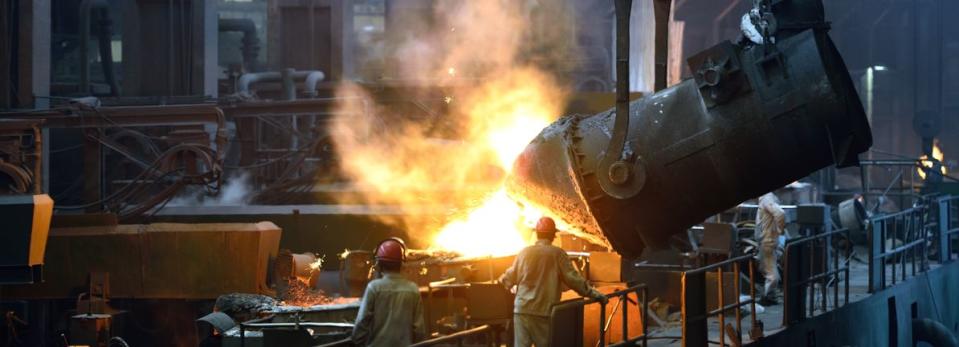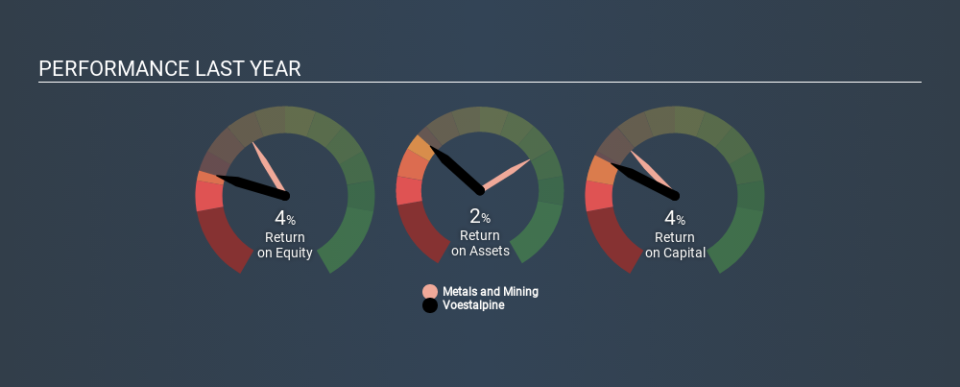Why We’re Not Keen On Voestalpine AG’s (VIE:VOE) 4.4% Return On Capital

Today we are going to look at Voestalpine AG (VIE:VOE) to see whether it might be an attractive investment prospect. Specifically, we're going to calculate its Return On Capital Employed (ROCE), in the hopes of getting some insight into the business.
First up, we'll look at what ROCE is and how we calculate it. Then we'll compare its ROCE to similar companies. Last but not least, we'll look at what impact its current liabilities have on its ROCE.
Understanding Return On Capital Employed (ROCE)
ROCE measures the amount of pre-tax profits a company can generate from the capital employed in its business. Generally speaking a higher ROCE is better. Overall, it is a valuable metric that has its flaws. Author Edwin Whiting says to be careful when comparing the ROCE of different businesses, since 'No two businesses are exactly alike.
How Do You Calculate Return On Capital Employed?
The formula for calculating the return on capital employed is:
Return on Capital Employed = Earnings Before Interest and Tax (EBIT) ÷ (Total Assets - Current Liabilities)
Or for Voestalpine:
0.044 = €500m ÷ (€16b - €4.9b) (Based on the trailing twelve months to September 2019.)
Therefore, Voestalpine has an ROCE of 4.4%.
See our latest analysis for Voestalpine
Does Voestalpine Have A Good ROCE?
ROCE is commonly used for comparing the performance of similar businesses. In this analysis, Voestalpine's ROCE appears meaningfully below the 9.0% average reported by the Metals and Mining industry. This performance could be negative if sustained, as it suggests the business may underperform its industry. Aside from the industry comparison, Voestalpine's ROCE is mediocre in absolute terms, considering the risk of investing in stocks versus the safety of a bank account. Investors may wish to consider higher-performing investments.
We can see that, Voestalpine currently has an ROCE of 4.4%, less than the 6.7% it reported 3 years ago. Therefore we wonder if the company is facing new headwinds. The image below shows how Voestalpine's ROCE compares to its industry, and you can click it to see more detail on its past growth.
It is important to remember that ROCE shows past performance, and is not necessarily predictive. Companies in cyclical industries can be difficult to understand using ROCE, as returns typically look high during boom times, and low during busts. ROCE is, after all, simply a snap shot of a single year. Given the industry it operates in, Voestalpine could be considered cyclical. Since the future is so important for investors, you should check out our free report on analyst forecasts for Voestalpine.
What Are Current Liabilities, And How Do They Affect Voestalpine's ROCE?
Short term (or current) liabilities, are things like supplier invoices, overdrafts, or tax bills that need to be paid within 12 months. Due to the way ROCE is calculated, a high level of current liabilities makes a company look as though it has less capital employed, and thus can (sometimes unfairly) boost the ROCE. To check the impact of this, we calculate if a company has high current liabilities relative to its total assets.
Voestalpine has total liabilities of €4.9b and total assets of €16b. As a result, its current liabilities are equal to approximately 30% of its total assets. Voestalpine's middling level of current liabilities have the effect of boosting its ROCE a bit.
What We Can Learn From Voestalpine's ROCE
Despite this, its ROCE is still mediocre, and you may find more appealing investments elsewhere. But note: make sure you look for a great company, not just the first idea you come across. So take a peek at this free list of interesting companies with strong recent earnings growth (and a P/E ratio below 20).
If you are like me, then you will not want to miss this free list of growing companies that insiders are buying.
If you spot an error that warrants correction, please contact the editor at editorial-team@simplywallst.com. This article by Simply Wall St is general in nature. It does not constitute a recommendation to buy or sell any stock, and does not take account of your objectives, or your financial situation. Simply Wall St has no position in the stocks mentioned.
We aim to bring you long-term focused research analysis driven by fundamental data. Note that our analysis may not factor in the latest price-sensitive company announcements or qualitative material. Thank you for reading.

